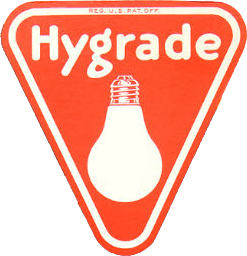
|

|
| News |
| Company History |
|
Categories
|
| Receivers |
| Speakers |
| Consoles |
|
Documentation
|
| Downloads |
| Service Manuals |
| Tube Tester Data |
|
Affiliates
|
| Bluefish |
| BitHistory |
|
You are visitor:
|
|
Since 2008-01-21
|
Company History
Merritt Manufacturing Company (1901)
Merritt Manufacturing Company was a business founded in early 1901 by Matthew M. Merritt in Middleton, Massachusetts,
to renew burned-out light bulbs. On July 31, 1901, Frank A. Poor, investing $3,500, became half-owner of the small
company. In November of 1901, due to dwindling resources, Merritt sold his half of the company to Frank Poor for $750.
Bay State Lamp Company (1901-1913)

Shortly after becoming the sole owner of Merritt Manufacturing, Poor moved the operation to Danvers, Massachusetts
and renamed it to Bay State Lamp Company. Frank was joined by his brother, Edward, and in 1907 the company was
officially incorporated. The company remained active until 1913 when the renewal portion of the business was abandoned.
Hygrade Incandescent Lamp Company (1909-1931)

In 1909, Hygrade Incandescent Lamp Company was organized to produce and sell new incandescent lamps. This was
an important leap for the future of the company, however, it was done for the simple matter that the future of the
renewal market was uncertain. Walter E. Poor joined the company in 1911 as it's first full-time engineer. He brought
to the company a strong emphasis on high quality, which soon became a permanent policy of the company. By 1912,
Hygrade extended their business to new tungsten-filament incandescent lamps. Sales were growing fast enough that
soon the facilities at Danvers were no longer adequate. As a result, in 1916, the company moved to 60 Boston Street
in Salem, Massachusetts.
In 1928, Neptron Corporation was formed to purchase Strong Manufacturing Company, a radio tube manufacturer from
Beverly, Massachusetts. These radio tubes were initially sold under the Neptron name, however, once all operations
were moved to the Salem location, they were then sold under the Hygrade brand name.
Novelty Incandescent Lamp Company, Inc. (1906-1921)
In 1906, Novelty Incandescent Lamp Company, Inc. was started in St. Marys, Pennsylvania. by Robert K. Mickey, with
financial backing from Charles J. Schaut and Alfred Schaut. Their intent was to manufacture and sell novelty shaped
bulbs, however, this never happened and they instead began by refilling lamps. In 1907, Josiah Howard of C. B. Howard
Company, purchased the company. A new factory was constructed in Emporium, Pennsylvania to produce new carbon-filament
lamps and the business was moved there. Benard G. Erskine was the electrical engineer responsible for laying out the
wiring for the new factory. He stayed on with the company after the project and became the superintendent of all
operations by 1909.
Due to years of unprofitable business, the Howards decided to jump ship leaving Erskine in charge as temporary
manager. Looking for new capital he found General Motors, who in 1910 purchased a 75% stake in the company and
made Erskine general manager, and eventually president. Due to changes at General Motors, in 1920 they sold the
Novelty assets to General Electric which made it their Keystone Lamp Division.
Nilco Lamp Works (1922-1931)

Due to the post-war depression in 1921, General Electric decided to close down Novelty. However, Erskine and two associates
(Joseph C. Wortman & Guy S. Felt) were able to purchase the assets for $350,000, with a $100,000 down payment. In
January of 1922, Nilco Lamp Works began it's independent operation and for the first time was in the hands of those
who had been managing it. In 1923, all lamp production was moved to the St. Marys facilities and the Emporium location
was used as a general office.
Sylvania Products Company (1924-1931)

In Spring of 1924, George Rishell, an engineer at Nilco, was given $500 to find out how to make a radio tube. Sylvania
Products Company was formed to manufacture the tubes resulting from that research. On Thanksgiving eve of that same
year, the first Sylvania radio tubes were shipped out of Emporium.
Tubes sales soon surpassed all expectations and by 1925, Sylvania radio tubes were being nationally advertised. Around
1927, Sylvania managed to attract Robert M. Wise, who had been one of RCA's chief tube designers for many years. In
1928, the company began sponsoring a radio program broadcast to 12 stations nationally. It featured the "Sylvania
Foresters," and orchestra composed entirely of employees from the Emporium factory. In 1929, a new factory was built
in Emporium and radio tubes became the major part of the Nilco-Sylvania business.
Hygrade Sylvania Corporation (1931-1942)

Around 1929, Philco Corporation had the idea to mass-produce and merchandise receiving sets with the tubes already in place.
Prior to this radios had been shipped without tubes in place which required them to be installed before use. Philco
quickly grew to be one of the largest set manufactures. Having selected both Hygrade and Sylvania as their tube
suppliers they were purchasing the majority of what each of the two companies was able to produce.
In part because of their relationships with Philco, in 1931 both companies decided to combine forces, forming Hygrade
Sylvania Corporation. Edward J. Poor became chairman of the board, and Benard G. Erskine became president of the new
company. All new lamps bore the Hygrade etch and all radio tubes the Sylvania etch. Post merger, Hygrade Sylvania was
the second largest producer of radio tubes, following RCA, and the third largest manufacturer of large-style incandescent
lamps after General Electric and Westinghouse. Combined executive and sales offices were opened in January 1933 on the
50th floor of 500 Fifth Avenue at 42nd Street in New York. However, offices were maintained in Salem and Emporium and
both parts continued to operate semi-independently.
Much of the '30s were spent filling out its lines as there were countless new tube types being developed each year. In
1931, Roger Wise, who was now the chief engineer of the Tube Division, developed the 6.3-volt line of battery-operated
tubes. In 1932, production of radio tube parts started, this was the beginning of vertical integration. In 1936, a new
radio tube production plant was completed on Loring Avenue in Salem, and all radio tube manufacturing was moved from
Bostom Street to this new location. In 1938, Hygrade Sylvania introduced the 1.4 volt tube, a Lock-In tube developed
by Roger Wise, and their first television picture tube which had been seven years in the making.
Also in 1938, Hygrade Sylvania introduced their first fluorescent lamp, a project they had been working on since 1931.
However, there were no fixtures available for these new lights so they had to build a fixture business as well. A
fixtures plant was opened in Ipswitch, Massachusetts, and Hygrade Sylvania was the first manufacturer to produce a
complete fluorescent lighting fixture, which was marketed as the Hygrade "Miralume." In 1941, construction modern
105,000 square foot fluorescent lamp factory was completed on Sylvan Street in Danvers and fluorescent production from
the Boston Street plant in Salem was transferred to the new factory. Also in 1941, the company purchased the fluorescent
powder division of the Patterson Screen Company in Towanda, Pennsylvania.
By 1939 the war in Europe had stimulated considerable business. Due to this new growth, in 1940, Walter Poor was
transferred to New York as executive vice-president to begin unifying the company. In February 1941, he established
a corporate industrial relations department under E. Finley Carter.
Sylvania Electric Products, Inc. (1942-1959)

A few months after Pearl Harbor, the company switched almost completely to war production. The war resulted in an
explosion of growth for the company. In 1941 they had 6 plants and about 6,000 employees, which by 1945 grew to 29
plants and a peak of over 30,000 employees. On August 12, 1942 Hygrade Sylvania Corporation became Sylvania Electric Products, Inc.
During this time vertical integration of the company was further expanded. By the end of the war Sylvania was building
a large part of it's special machinery, it had a tungsten and chemical plant, and a parts operation.
In July 1941, L. Grand Hector and Dr. Raymond D. Mindlin of the National Defense Research Council visited Roger Wise and
asked if Sylvania would be interested in developing rugged tubes for a highly secret government project. This project
was as the VT (variable time) or proximity fuse. Although other companies had already begun working on the project,
Sylvania was the first to produce a satisfactory design which met all the prescribed tests. In March 1942, they were
awarded their first sizable contract for the production of the VT tubes. In spring of 1942, Dr. Lawrence R. Hafsted and
Dr. Herbert Trotter, Jr., of Section T of the Office of Scientific Research and Development, met with Walter Poor and
Roger Wise and asked if they would be interested in making fuses. Just 29 days after they got the contract, the fuses
they produced were successfully tested at a Naval gun testing station. While these were the company's major efforts during
the war, work also extended into many diverse areas. The Special Products Department of the Lighting Division developed
and manufactured complete radar systems.
In November 1942, Don G. Michell was brought in as the company's first vice-president of sales.
In 1944, Walter Poor established a central research facility in Bayside, New York, for advanced research and development.
Known as the Sylvania Research Center it was designed to eliminate duplication of efforts in specialized fields and to
solve specialized engineering problems at the various plants. Also in 1944, Colonial Radio Corporation of Buffalo, New
York was purchased and it became the Radio and Television Division. In 1946, Wabash Corporation was created to
purchase Wabash Appliance Corporation, Wabash Photolamp Corporation, Birdseye Electric Corporation, and their affiliates,
which were merged into the Lighting and Fixtures Division.
As the war wound down, in August 1945, Sylvania combined the Salem Lighting Division, and the Williamsport Industrial
Apparatus Section of the Tube Division into a new Industrial Electronics Division. The Emporium plant was converted from
the production of tubes for the Army and radar scopes for the Navy to television picture tubes. Additional plants in were
purchased in 1948 in Ottawa, Ohio, and in 1949 in Seneca Falls, New York, for the production of television picture tubes.
In 1948, Colonial Radio was reorganized and tooled up for the production of its first television sets for Sears, Roebuck &
Company. The first complete line of television sets was released under the Sylvania name in 1949.
In May 1950, Sylvania's executive offices in New York were moved to the new Mutual Life Insurance Building at 1740
Broadway. The International Division and various administrative offices also moved to this location. In September 1950,
in an attempt to increase the public awareness of the company's name, Sylvania assumed the sponsorship of the popular
"Beat the Clock" show on CBS-TV. In 1951, Sylvania created the annual Sylvania Television Awards to try and improve the
quality of color television programming. Also in 1951, Sylvania Electric Products celebrated their 50th anniversary.
In 1951, an Atomic Energy Division was formed following the receipt of a sizable contract from the Atomic Energy Commission
for the development of fuel elements for atomic reactors. In 1952 a new 50,000 square foot metallurgical laboratory was
opened at the Sylvania Research Center and was used mainly for this work. In 1954, the company's ninth product division,
the Electronic System Division was formed in Buffalo, New York. The primary purpose of this division was to consolidate
the company's work in military electronics, and included a new electronic defence laboratory in Mountain View, California.
Also in 1954, a Sylvania Data Processing Center was established in Camillus, New York. It's role was to consolidate
financial, production, marketing, and other vital information for use by management. More than 60 Sylvania facilities in 20
states fed data to the center through a 12,000-mile leased Western Union network.
In 1954, Sylvania completed construction of their largest facility, a 422,000 square foot television-set assembly
plant in Batavia, New York. In 1956, Sylvania pioneered the 110 degree picture tube and receivers. Also in 1956, Sylvania
acquired Argus Cameras, Inc., who was at the time, the worlds largest manufacturer of 35mm cameras. In 1957, Sylvania
teamed with Corning Glass Works to form Sylvania-Corning Nuclear Corporation (Sylcor) and a new commercial fuel-element
plant was built in Hicksville, New York. At the same time, the Electronics Division in Woburn, Massachusetts, was divided
into two new organizations, the Semiconductor Division and Special Tube Operations. This was done primarily due to
intensified efforts to establish a meaningful position in the rapidly growing semiconductor industry.
General Telephone & Electronics Corporation (1959-1971)

On March 5, 1959, Sylvania merged with General Telephone to create General Telephone & Electronics Corporation. Donald
Power was elected chairman and chief executive office, and Don Mitchell was elected president. The two companies
headquarters were integrated within the new General Telephone Building at 730 Third Avenue in New York City. Sylvania
continued to operate under the Sylvania Electric Products name.
This was the beginning of a massive change for Sylvania as the two companies tried to integrate and return to
profitability. The Sylvania Television Awards were canceled after it's ninth dinner in January 1959. In November 1959,
GT&E purchased the remaining two-thirds interest in Lenkurt Electric Company, Inc., having acquired the first one-third
with Automatic Electric in 1955. In January 1960, GT&E Laboratories was formed with Sylvania's Central Research
Laboratories as it's nucleus. GT&E International was formed to consolidate the manufacturing and marketing activities
of Sylvania, Automatic Electric, and Lenkurt outside the United States.
Sylvania-Corning Nuclear Corporation was partially sold to National Lead and the remainder merged with Sylvania's
Chemical-Metallurgical Division, the former tungsten and chemical unit. In December 1960, at the Eastern Joint Computer
Conference, a new computer called the Sylvania 9400 was the central feature of a large GT&E display. This computer was
was an attempt to commercialize a project called MOBIDIC (mobile digital computer), which was developed for the Army
Signal Corps. However, GT&E was unwilling to compete with IBM, so the Sylvania 9400 was canceled.
In 1961, Gene Beare became president of Sylvania, Donald Power was re-elected chairman and chief executive officer of
GT&E, Don Mitchell vice chairman, and Leslie Warner president. In 1962, Don Mitchell resigned as vice chairman of GT&E.
Also in 1962, Argus was sold to Mansfield Industries, who then changed their name to Argus, Inc. Dr. Lee L. Davenport
was elected president of GT&E Laboratories.
In 1963, Sylvania resumed full-scale production of color television tubes. In June 1964, Gene Beare introduced
Sylvania's 1965 line of color television sets using their new Color Bright 85 picture tube. The Color Bright 85 was
the first tube to use Sylvania's new rare-earth red phosphor, which finally performed as good as those used for green
and blue. This resulted in a much brighter picture with better balanced colors and allowing for finer picture detail.
This innovation provided a major boost in profits for the Chemical and Metallurgical, Electronic Tube, and Entertainment
Products Divisions as well bolstering Sylvania's reputation as a leader in the field. By 1965, they were providing
color tubes to 18 of the country's 23 color television set manufactures. Also in 1965, GT&E Communications, Inc. was
formed to provide CATV (community-antenna television) to customers in communities where reliable television reception
was not available. By the end of 1966, operations of this new unit included 31 franchise locations.
In early 1965, Sylvania's Lighting Products Division introduced a revolutionary "flashcube." Containing four tiny
flashbulbs, the flashcube rotated automatically after each photo was taken. In June 1967, Sylvania acquired Ultronic
Systems Corp. of Mount Laurel, New Jersey, and placed it in a newly formed operating group, Sylvania Information
Systems, which also included the Commercial Electronics Division in Bedford, Massachusetts. Later in September 1967,
Sylvania bought Wilbur B. Driver Co. of Newark, New Jersey, and again placed it in a newly formed operating group,
Sylvania Metal and Chemicals, along with Sylvania's Chemical and Metallurgical and Parts Divisions. In 1968, GT&E
International acquired controlling interest in SABA GmbH of West Germany. Wireless Products, Ltd. of Hong Kong was also
acquired and renamed Sylvania Far East, Ltd.
In July 1969, Garlan Morse became president of Sylvania. A few months later Leonard A. Muller became senior vice-president
of Sylvania and head of the Information Systems unit. Muller brought in several new operations of the Information Systems
unit, they were Chester Electronic Laboratories, Inc., of Chester, Connecticut; Programming Methods Incorporated of New
York City; Novar Corporation of Mountain View, California; and Tempo Computers, Inc., of Fullerton, California. By late
1970, Sylvania Information Systems became a full subsidiary of GT&E under the name GT&E Information Systems Incorporated.
Also in 1970, Sylvania's Lighting Products Group introduced the magicube, a self-powered, four shot flashcube.
GTE Sylvania Incorporated (1971-1993)

In January 1971, GT&E adopted a new corporate identification program, and became simply, GTE. This program was also
applied to subsidiary companies, and as such, Sylvania Electric Products became GTE Sylvania Incorporated. Merle Kremer
became president of GTE Sylvania. In June 1973, GTE moved into their new world headquarters in Stamford, Connecticut.
Also in 1973, GTE Sylvania formed a new Electrical Equipment Group and Architectural Products Group. The Electrical
Equipment Group was formed with the acquisition of Zinsco Electrical Products Co., of St. Louis, Missouri. In 1974, Clark
Control, Inc., and Canadian Controllers, Ltd. also became part of the new group. The Architectural Products Group was
composed of the Lighting Equipment Division and the purchase of Unistrut Corporation. In 1974, GTE Sylvania acquired the
Philco name and domestic distribution rights for television sets and stereo consoles manufactured by the Philco-Ford
subsidiary of the Ford Motor Company. They would also design and manufacture the Philco units for sale through Philco
distributors and dealers across the United States.
Sources
Newcomen Address: Sylvania during 50 years, 1901-1951 (The Newcomen Society) 1951
The History of GTE - The Evolution of One of America's Great Corporations (Thomas E. McCarthy) 1990
The History of GTE - The Evolution of One of America's Great Corporations (Thomas E. McCarthy) 1990
|
Support
|
| Contribute |
| Auctions |
|
Links
|
| AudioKarma |
| HiFi Engine |

|

|

|

|

|

|

|

|

|
|
0.0034s
|
This site, including the layout and all contents, are property of Hannah Novak and shall not be reused or modified without prior written permission.




